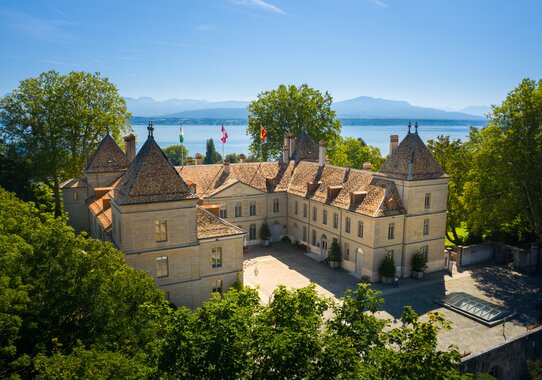accessibility.sr-only.body-term
The diary of Anne Frank is world famous. It is less well known that the journey to global publication began in Switzerland. While Anne, her sister and her mother were killed in the concentration camp, Anne’s father was the only family member to survive the Holocaust. Otto Frank moved to live with his sister in Basel in the 1950s. From there, he made it his task to share his daughter’s diary with the world whilst preserving her message on humanity and tolerance for the coming generations.
In collaboration with Anne Frank Fonds, Basel, and Familie Frank Zentrum im Jüdischen Museum Frankfurt
Come and spend some time with us, we propose a large selection of activities for different target groups. A motivated and experienced team is awaiting you.
Guided tours can also be arranged outside of the official opening hours upon request.
|
Registration |
2 weeks in advance |
|
|
Duration |
60 minutes; special arrangements available upon request |
|
|
Group size |
max. 25 people per tour |
|
|
Languages |
German, French, Italian and English. Others upon request. |
|
|
Cost |
CHF 120 for the guided tour + CHF 10/person admission Children up to 16 years free. |
accessibility.sr-only.person_card_info Contact
Noblesse Oblige! Life at a Château in the 18th Century – now for the 21st
The permanent exhibition on the historical heritage of Château de Prangins is revamping its image, with a boldly contemporary and unselfconscious poster designed to attract new audiences. While remaining faithful to its content and spirit, the exhibition is now enhanced by an exceptional object: a rare, 18th-century tureen. Visitors are invited to discover – or rediscover – the exhibition at a special free open day on 2 March.
Opened in March 2013, Noblesse Oblige! Life at a Château in the 18th Century is the centrepiece of the presentation at Prangins, which has been home to the Swiss National Museum in French-speaking Switzerland since 1998. It features a number of former reception rooms that have been returned to their former splendour amidst a décor that invites visitors to take a fascinating journey back into the daily life of the Guiguer family, who built the property and lived there for four successive generations during the Enlightenment, overseeing an extensive agricultural estate.
Twelve years on from its inauguration, the exhibition remains as relevant and historically interesting as ever, but is now looking to appeal to new audiences. The communication campaign, created by L’ADMP (Nyon) and Clay Studio in collaboration with photographer Nicolas Coulomb, plays with the contrast between past and present and draws on the evocative, even iconoclastic power of fashion photography offers a new perspective on the boiseries in their original colours, textiles with lustrous motifs and false marble that serve as the backdrop for some 600 period objects.
In addition, the exhibition now boasts an exceptionally rare new item: a silver tureen dating from the 18th century that belonged to the Ployard family, friends and relatives of the Guiguers who had settled in Geneva. Used to serve stew, it was acquired by the Swiss National Museum in 2021 and now takes pride of place in the large dining room on the ground floor. An ad-hoc presentation in three languages details its history and value.
Finally, expanding the museum’s cultural education activities, a visitor guide in easy-to-read French is now available, along with a new, fun and informative quiz game for families to explore the exhibition.
A special open day on 2 March will mark the launch of the new image for Noblesse Oblige!, the tureen display and the new educational resources.
Images
Tatiana Oberson
Head of Marketing, Communication & Fundraising
- General Management Swiss National Museum Denise Tonella
- Management Swiss National Museum – Château de Prangins Helen Bieri Thomson
- Project management Nicole Staremberg in collaboration with Jonathan Fellay
- Curators Erika Hebeisen, Rebecca Sanders
- Scientific researchers Marina Amstad, Manda Beck, Thomas Bochet, Noëmi Crain Merz, Aaron Estermann,
- Marketing and communication Tatiana Oberson, Sylvie Nickbarte
- Advertising graphic design Resort GmbH für visuelle Kommunikation
- Cultural Services and Museum Education Marie-Dominique de Preter, Jonathan Fellay, Ines Berthold, Sylvain Frei, Valérie Guillermin, Debra Kinson, Nathalie Pellissier, Geneviève Suillot, Anne-Capucine Vernain, Madeleine Wüthrich
- Exhibition design Kläfiger muséographie: Stéphane Kläfiger
- Exhibition graphic design Enzed – Graphic Design: Nicolas Zentner, Mathieu Moret
- Exhibition furniture Actoform
- Decorator Nigro & Fils Peinture
- Printing Meylan publicité, Concise ; BSR-Imprimeurs, Gland
- Film The Rise of National Socialism Gabriel Heim, Bâle
- Animation and illustration Nino Christen, Maj Dörig, Zurich
- Exhibition construction Brandenberger, Atelier Goodwood
- Lighting André Schärer
- Conservation management Elke Mürau
- Conservation and mounting of objects Anna Jurt, Jürg Mathys, Tino Zagermann
- Logistics and montage of objects Christian Affentranger, David Blazquez, Simon D'Hollosy, Reto Hegetschweiler, Markus Scherer
- Loan services Laura Mosimann, Claudio Stefanutto, Samira Tanner
- Photography Jörg Brandt
- Picture library Andrea Kunz, Fabian Müller
- IT | Web René Vogel, Danilo Rüttimann
- Media stations Thomas Bucher, Ulrich Heiniger, Pasquale Pollastro, Danilo Rüttimann, René Vogel
- Translations Marie-Claude Buch-Chalayer, Bill Gilonis, Marco Marcacci, Laurence Neuffer
- Alice und Louis Koch-Stiftung, Basel
- Anne Frank Fonds, Basel
- Appenzeller Brauchtumsmuseum, Urnäsch
- Archiv für Zeitgeschichte ETH Zürich
- Familie Frank Zentrum im Jüdischen Museum Frankfurt, Dauerleihgabe des Anne Frank Fonds, Basel, und der Familie Elias-Frank
- Gedenkstätte Bergen-Belsen, Lohheide
- Historisches Museum Basel
- Joods Museum, Amsterdam
- Jüdisches Museum der Schweiz, Basel
- Kantons- und Universitätsbibliothek, Freiburg
- Museum Altes Zeughaus, Solothurn
- Museum für Gestaltung Zürich, Zürcher Hochschule der Künste
- Plakatsammlung, Schule für Gestaltung Basel
- Fishel Rabinowicz, Locarno
- Urs Rudolf, Solothurn
- Bernard Schüle, Affoltern a. Albis
- Stichting tot Behoud van Historische Philips Produkten (SBHP), Eindhoven
- Stiftung Museum im Zeughaus, Schaffhausen

